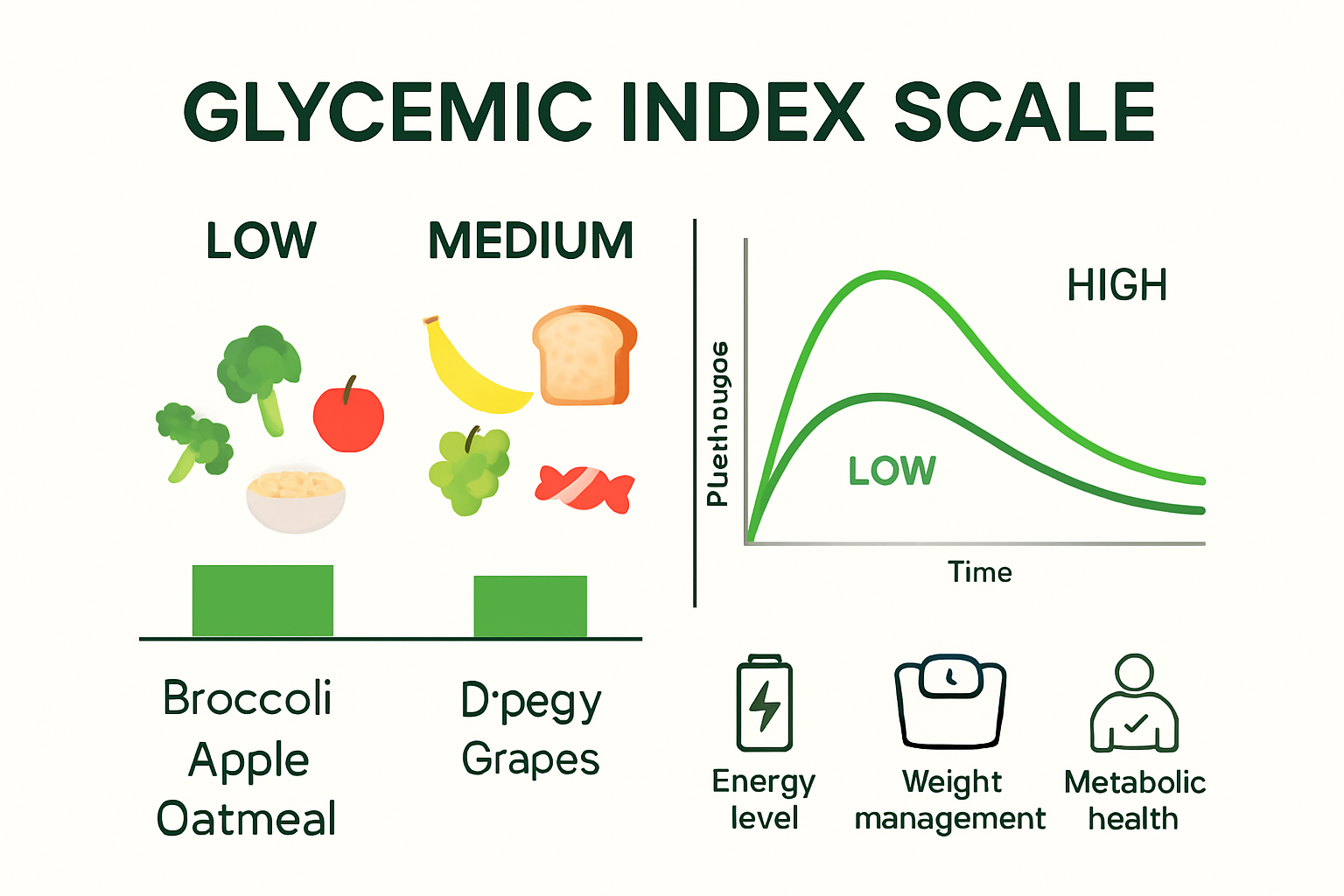Most people think all carbs affect your body the same way, but the glycemic index turns that idea upside down. Surprise. A steaming bowl of oatmeal has a much lower glycemic impact than a slice of white bread, even though both are breakfast staples. And get this, switching to low-GI foods like lentils and steel-cut oats has been shown to help maintain stable blood sugar, which can lower your risk of chronic disease and help with weight management. That flips standard diet advice on its head and opens up smarter choices for 2025.
Table of Contents
- What Is Glycemic Index And Why It Matters
- How Glycemic Index Affects Your Body
- Choosing Low-GI Foods For Better Health
- Practical Tips For Using Glycemic Index Daily
Quick Summary
| Takeaway | Explanation |
|---|---|
| Understand Glycemic Index for Better Choices | The glycemic index ranks foods by how they affect blood sugar levels, which aids smart food selections. |
| Opt for Low-GI Foods | Choose low-GI foods like vegetables, whole grains, and legumes to maintain stable blood sugar levels. |
| Balance Meals with Proteins and Fats | Combine high-GI foods with proteins or healthy fats to slow glucose absorption and prevent spikes. |
| Practice Smart Cooking Methods | Use cooking techniques like steaming or boiling to keep foods’ glycemic index lower. |
| Monitor Individual Reactions to Foods | Each person’s response to foods can differ, so track your responses and consult healthcare professionals. |
What Is Glycemic Index and Why It Matters
Understanding glycemic index (GI) is crucial for making smart nutritional choices that impact your overall health and metabolism. At its core, the glycemic index is a numerical ranking system that measures how quickly different foods containing carbohydrates raise blood glucose levels.
Decoding the Glycemic Index Scale
The following table summarizes the glycemic index scale and provides examples of foods in each classification to help make informed dietary choices:
| GI Category | GI Range | Characteristics | Example Foods |
|---|---|---|---|
| Low GI | 0-55 | Slow, gradual blood sugar rise | Most vegetables, legumes, whole grains, nuts |
| Medium GI | 56-69 | Moderate blood sugar response | Whole wheat products, certain fruits |
| High GI | 70-100 | Rapid blood sugar spikes | White bread, sugary drinks, processed snacks |
The GI scale ranges from 0 to 100, with specific classifications that help people make informed dietary decisions. Harvard T.H. Chan School of Public Health provides clear insights into these classifications:
- Low GI Foods (0-55): These foods cause a slow and gradual rise in blood sugar. Examples include most vegetables, legumes, whole grains, and nuts.
- Medium GI Foods (56-69): These foods produce a moderate blood sugar response. Whole wheat products and certain fruits fall into this category.
- High GI Foods (70-100): These foods trigger rapid blood sugar spikes. White bread, sugary drinks, and processed snacks are typical high GI foods.
Why Blood Sugar Management Matters
Blood sugar management isn’t just about preventing diabetes. It impacts multiple aspects of health, including energy levels, weight management, and long-term metabolic function. National Institutes of Health research indicates that consistent blood sugar fluctuations can lead to insulin resistance, increased inflammation, and higher risks of chronic diseases.
The glycemic index provides a scientific approach to understanding how different foods interact with your body’s metabolic processes. By choosing lower GI foods, individuals can achieve more stable energy levels, reduce sudden hunger pangs, and support overall metabolic health. This approach goes beyond simple calorie counting, focusing on the quality of carbohydrates consumed.
For individuals managing weight, diabetes, or seeking optimal nutrition, understanding the glycemic index becomes a powerful tool. It allows for more nuanced food choices that support sustained energy, better nutrient absorption, and long-term health outcomes. Whether you’re an athlete, someone managing a chronic condition, or simply interested in optimal nutrition, the glycemic index offers valuable insights into making smarter dietary decisions.
How Glycemic Index Affects Your Body
The glycemic index (GI) plays a critical role in understanding how different foods impact your body’s metabolic processes and overall health. Beyond simple nutrition, GI reveals the intricate relationship between food consumption and physiological responses.
Metabolic Response and Insulin Dynamics
Harvard T.H. Chan School of Public Health explains that different carbohydrates trigger varying metabolic responses. When you consume high GI foods, your body experiences rapid blood glucose elevation, prompting a swift insulin release. This sudden surge can lead to significant metabolic fluctuations. Conversely, low GI foods induce a more gradual glucose absorption, supporting more stable metabolic function.
The physiological implications are profound. Repeated high GI food consumption can strain your pancreas, potentially contributing to insulin resistance over time. This metabolic stress may increase risks of type 2 diabetes, weight gain, and other chronic health conditions.
Long-Term Health Implications
Nutrients Journal research highlights the broader health consequences of glycemic index. Low GI diets demonstrate significant benefits in managing metabolic syndrome, improving cardiovascular health, and supporting sustained energy levels. The study reveals that consistent consumption of low GI foods can:
- Enhance Insulin Sensitivity: Gradual glucose absorption helps maintain more consistent insulin levels.
- Support Weight Management: Slower digestion promotes longer-lasting satiety and reduces frequent hunger signals.
- Reduce Inflammation: Stable blood sugar levels can decrease systemic inflammation markers.
Beyond immediate metabolic responses, glycemic index influences multiple physiological systems. Your body’s intricate hormonal balance, energy metabolism, and cellular function are all interconnected with the foods you consume. Understanding these nuanced interactions empowers individuals to make more informed dietary choices that support long-term wellness.
Consider glycemic index not as a restrictive diet plan, but as a strategic approach to nutrition. By selecting foods that promote stable blood sugar and support metabolic health, you can optimize your body’s natural processes, enhance energy levels, and potentially mitigate risks associated with metabolic disorders.
Choosing Low-GI Foods for Better Health
Navigating the world of low-glycemic index (GI) foods requires strategic knowledge and intentional food choices. Making informed decisions about your diet can significantly impact your metabolic health and overall well-being.
Strategic Food Selection
Below is a summary table of recommended food categories and representative examples for low-GI eating, based on the foods mentioned in the article:
| Food Category | Example Foods |
|---|---|
| Vegetables | Leafy greens, broccoli, cauliflower |
| Legumes | Beans, lentils, chickpeas |
| Whole Grains | Quinoa, steel-cut oats, barley |
| Fruits | Berries, apples, citrus fruits |
Harvard T.H. Chan School of Public Health recommends focusing on whole, minimally processed foods that naturally provide stable blood sugar responses. Low-GI food categories include:
- Vegetables: Non-starchy options like leafy greens, broccoli, and cauliflower
- Legumes: Beans, lentils, and chickpeas
- Whole Grains: Quinoa, steel-cut oats, and barley
- Fruits: Berries, apples, and citrus fruits
Meal Planning and Preparation
National Institutes of Health research indicates that consistent low-GI food consumption can improve metabolic health. When planning meals, consider combining different food groups to further moderate glucose absorption. For instance, pairing a carbohydrate with protein or healthy fat can slow digestion and reduce blood sugar spikes.
To make your nutritional journey easier, we have developed a comprehensive guide to identifying low-GI foods that can help you make smarter dietary choices. Understanding food preparation methods also matters. Cooking techniques like steaming, boiling, and baking can help maintain lower glycemic responses compared to frying or processing.
Practical strategies include reading nutrition labels, understanding ingredient lists, and being mindful of portion sizes. Not all carbohydrates are created equal. Whole foods with high fiber content typically have lower GI values and provide more sustained energy. By prioritizing nutrient-dense, minimally processed foods, you can effectively manage your blood sugar levels and support long-term metabolic health.
Remember that individual responses to foods can vary. While general guidelines are helpful, paying attention to your body’s unique reactions and consulting healthcare professionals can provide personalized insights into optimal nutrition strategies.
Practical Tips for Using Glycemic Index Daily
Integrating glycemic index (GI) principles into daily life requires thoughtful strategies and practical approaches. Understanding how to apply GI knowledge can transform your nutritional habits and support long-term metabolic health.
Smart Meal Composition
The table below summarizes practical strategies for creating balanced, low-GI meals based on the combinations recommended in the article:
| Strategy | Example Application |
|---|---|
| Protein Pairing | Add chicken, fish, or tofu to carb-rich meals |
| Fat Integration | Include avocado, nuts, or olive oil |
| Fiber Boosting | Incorporate vegetables or legumes |
Harvard T.H. Chan School of Public Health recommends creating balanced meals that moderate blood sugar responses. The key is combining different food groups strategically. For instance, pairing a higher GI food with protein, healthy fats, or fiber can slow glucose absorption and reduce sudden blood sugar spikes.
Practical meal-planning techniques include:
- Protein Pairing: Add lean proteins like chicken, fish, or tofu to carbohydrate-rich meals
- Fat Integration: Include healthy fats from avocados, nuts, or olive oil
- Fiber Boosting: Incorporate vegetables or legumes to increase meal complexity
Cooking and Food Preparation
Nutrients Journal research reveals that food preparation significantly impacts glycemic response. Cooking methods, ingredient ripeness, and processing can alter a food’s glycemic index. For precise tracking, we recommend exploring our detailed glycemic index calculator to understand how different preparation techniques affect food’s metabolic impact.
Some practical preparation tips include:
- Choosing cooled starches like potato salad or chilled rice, which have lower GI
- Selecting less processed grains
- Steaming or boiling instead of frying
- Consuming fruits before full ripeness to reduce sugar content
Daily implementation of glycemic index principles doesn’t require extreme dietary overhauls. Small, consistent changes can yield significant metabolic benefits. By becoming more mindful of food choices, preparation methods, and meal composition, you can support stable energy levels and long-term health. Always remember that individual responses vary, so pay attention to how your body reacts and consult healthcare professionals for personalized guidance.
Frequently Asked Questions
What is the glycemic index?
The glycemic index (GI) is a numerical ranking system that measures how quickly different carbohydrates raise blood glucose levels. Foods are categorized as low, medium, or high GI based on their impact on blood sugar.
Why is blood sugar management important?
Managing blood sugar is crucial for preventing diabetes, maintaining energy levels, and supporting overall metabolic health. Consistent blood sugar fluctuations can lead to insulin resistance and increase the risk of chronic diseases.
How can I choose low-GI foods?
To choose low-GI foods, focus on whole, minimally processed options like vegetables, legumes, whole grains, and certain fruits. Check the glycemic index scale to identify foods that promote stable blood sugar levels.
What are some practical tips for applying glycemic index principles in daily life?
Incorporate low-GI foods into your meals by pairing carbohydrates with proteins and healthy fats. Use cooking methods like steaming or boiling, and monitor individual responses to various foods for optimal health.
Ready to Take Control of Your Glycemic Index in 2025?
Reading about the glycemic index is enlightening, but actually putting that knowledge into your daily routine can feel overwhelming. If you struggle with finding the right foods, planning balanced meals, or consistently managing your blood sugar, you are not alone. The article highlighted how navigating low-GI foods and understanding meal composition can make or break your long-term health goals. But figuring out which foods fit, how to cook them, and keeping track of the results can feel complicated fast.
Imagine simplifying all those choices with expert-backed, AI-powered meal planning. Let Dietium.com’s Recipians app turn your nutrition education into actionable steps. Discover tailored custom meal plans and recipe ideas built around GI-friendly foods and your personal health needs. Take the next step to stable energy, healthier habits, and easy food tracking.
Act now and see how Dietium.com can help you make confident decisions for your healthiest year yet.






